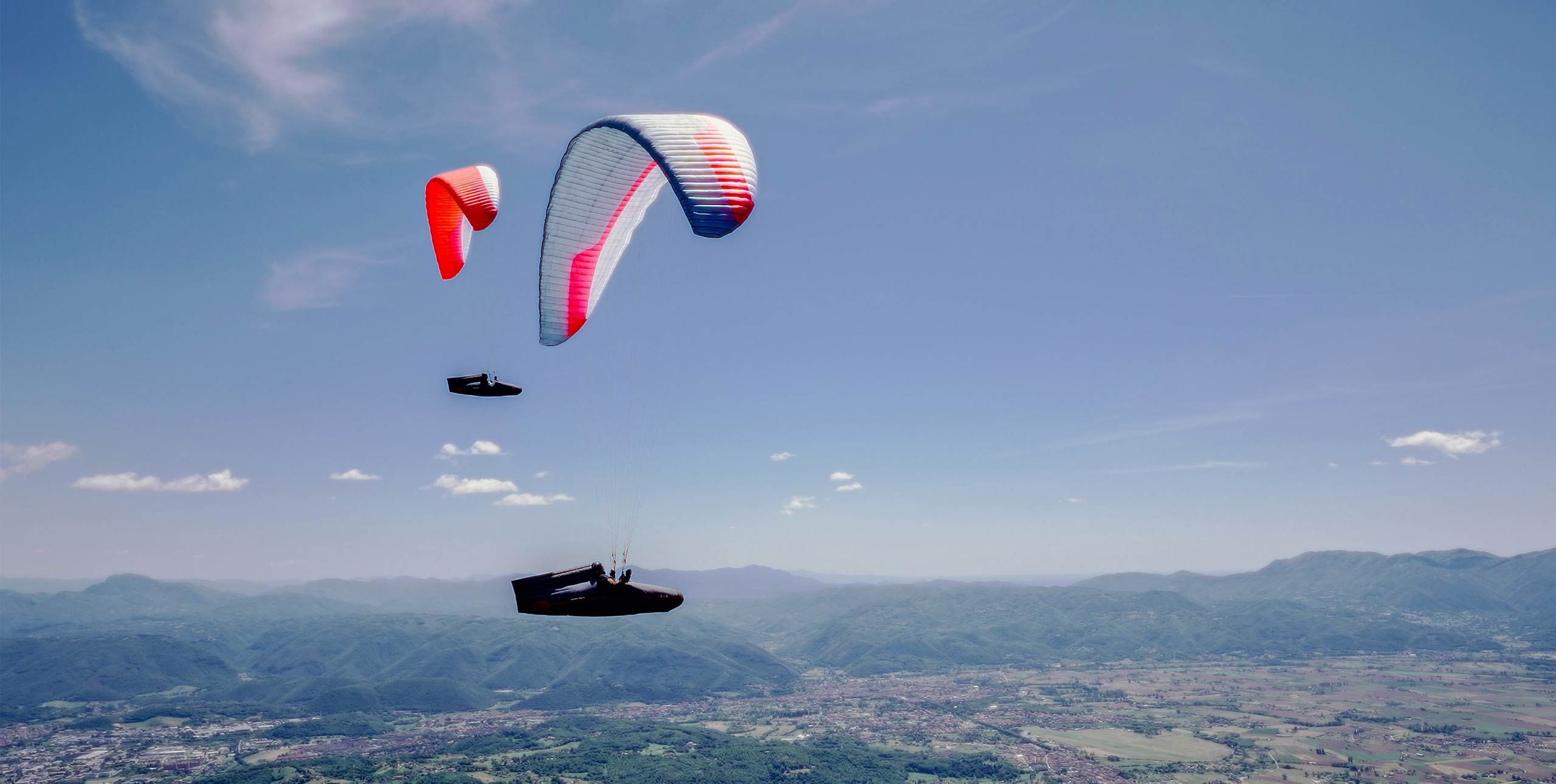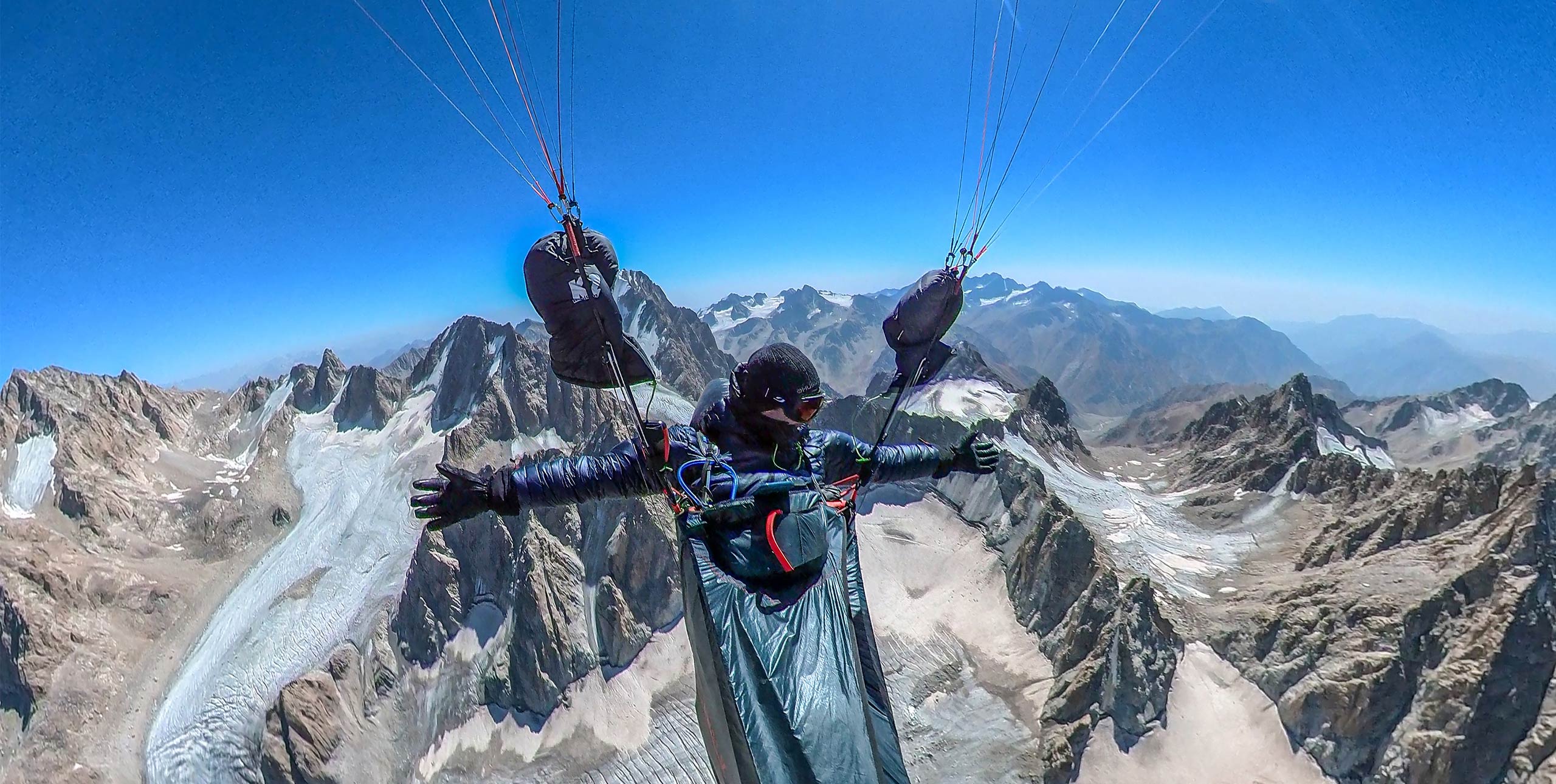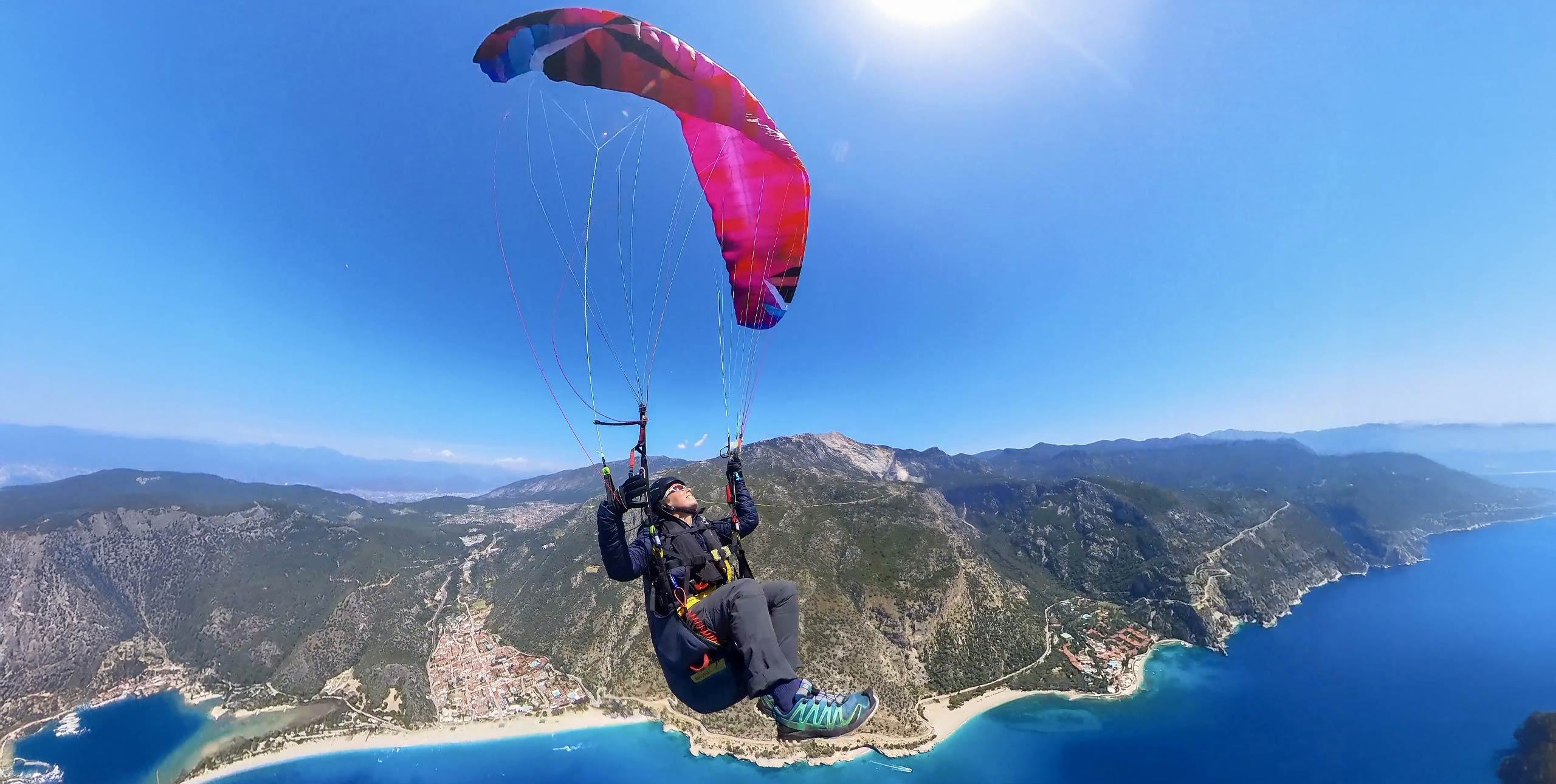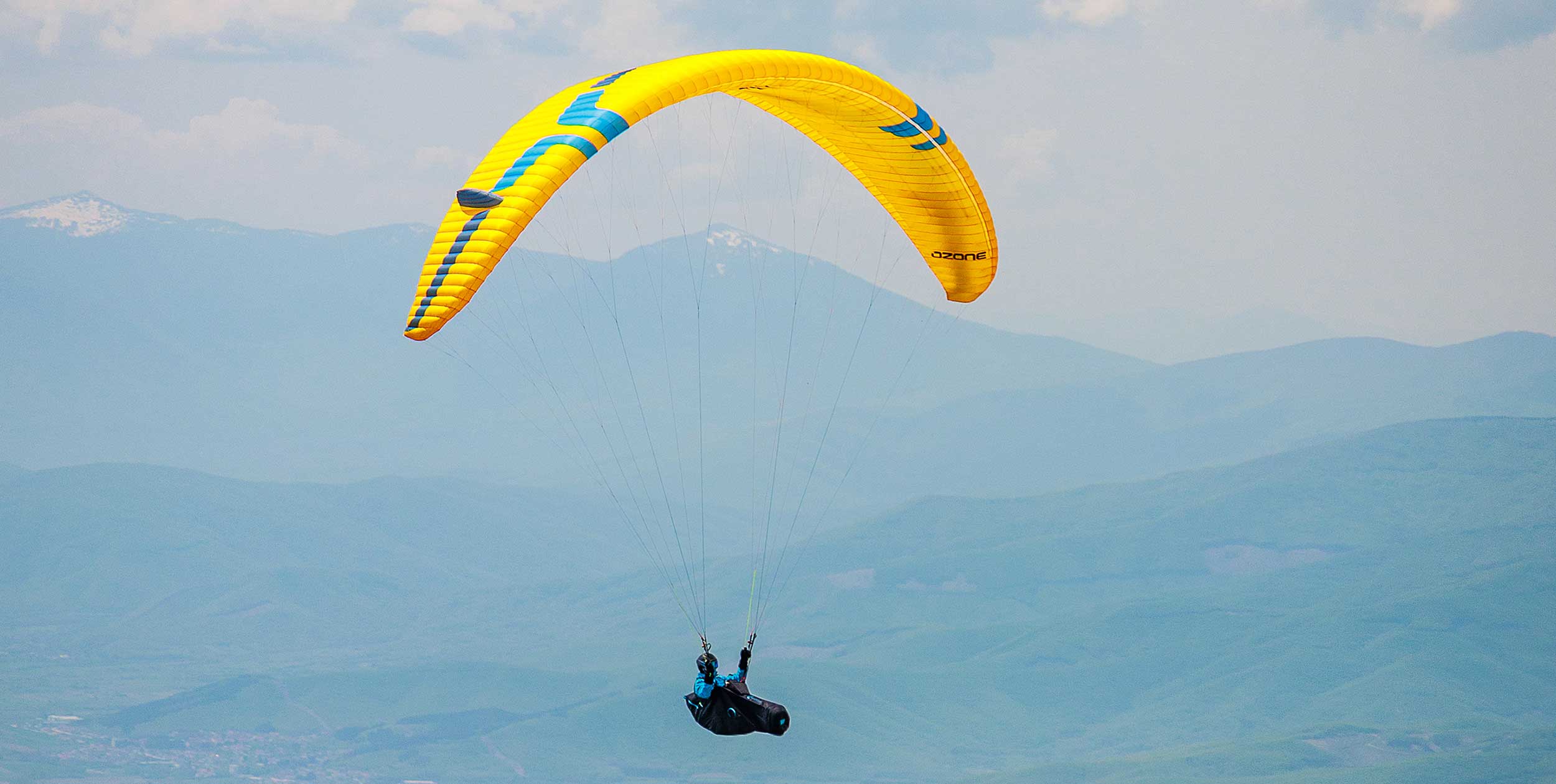
The Photon was probably the worst-kept secret in our sport. As soon as the rules for folding lines were changed, allowing the creation of two-line wings in the EN-C class, the forums exploded with chat on what Ozone would bring to market. As creators of the whole two-line revolution with the Baby HPP back in 2009, and lots of experience making such wings, people were excited to see what they would bring to the market.
Ozone announced the release of the Photon at the Stubai Cup in March 2023 and I flew it there for a brief test flight.
A month later a full production model arrived.
Unwrapping
The production wing was delivered in Ozone’s lightweight concertina bag and inside it was wrapped around an inflatable pillow and two cardboard tubes. Yes, there are a lot of plastic rods in the wing and you have to make sure you avoid bending them too tightly. In practice you can fold the wing around your folded harness and it is no different to other wings in this class.
Ozone pitch the Photon as a sport class two-liner with “near-competition class performance.” It “represents the missing link between conventional three-liners and high performance wings such as the Zeno 2” they say.
Unfold it and you will find an aspect ratio of 6.5, which clearly positions it higher in the Ozone range than the current EN-C Delta / Alpina wings (both AR 6.0). An aspect ratio of 6.5 is the same as the AirDesign Volt and Nivik Artik R and slightly higher than the Gin Bonanza 3, Drift Merlin and Skywalk Mint and less than the Swing Libra RS with its AR of 6.9.
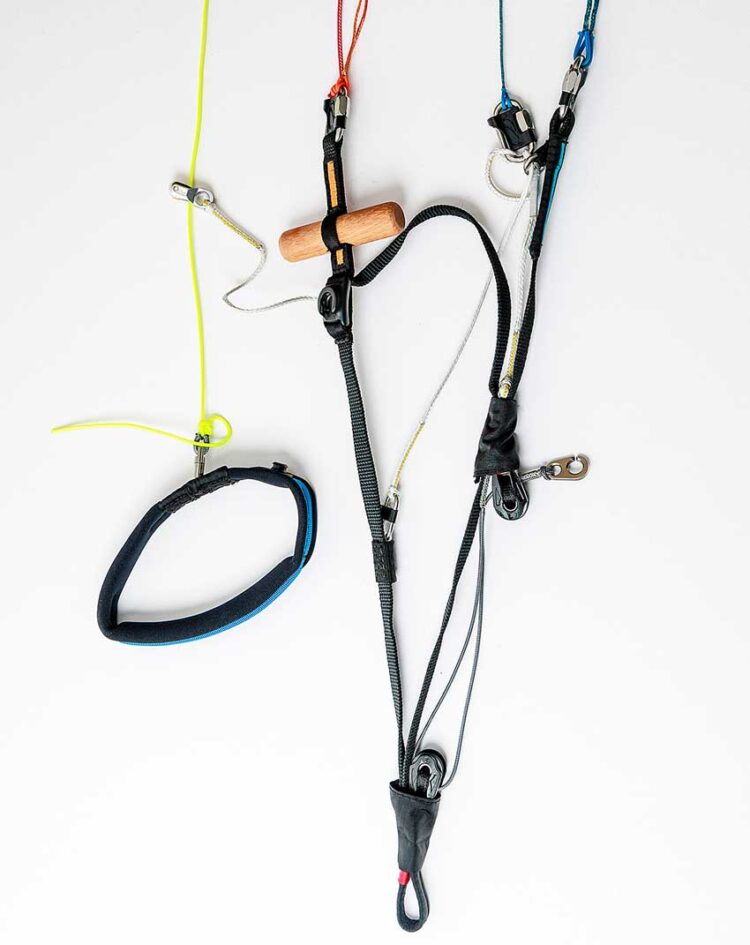
Design and construction
With 71 cells the Photon has the highest cell count of the new EN-C two-liners, making for a better definition of the aerofoil shape with less ballooning as the cells are smaller. The leading edge is supported by plastic rods which run a long way back across most of the chord. There is of course a sharknose. The leading edge is further supported by G-strings running across the centres of the cell openings: they help keep the shape of the aerofoil and stop vibrations at speed and Ozone make extensive use of them on their wings.
With the wing pulled up above your head you will notice the high arc. Ozone say this improves the handling as well as making it react better when a collapse occurs. The other noticeable feature is the winglets on the top surface. Designer Luc Armant told us they are there as a safety feature, to help dampen and improve the exits of deep spirals. Another benefit is, “roll damping – making control of the yaw/roll movements easier for less experienced pilots.”

Materials
The Photon uses a semi-light mix, with Dominico D20 on the top surface and Porcher 27 single-coated on the bottom. With the large cell count and a complicated internal structure the wing isn’t light by any means, but at 5kg for the ML it is lighter than the equivalent Delta 4 by 300g.
As you would expect the entire line set is unsheathed, but the lines are brightly coloured and so are easy to prepare on launch. Those closest to the wing are pretty damn thin, looking more like thread for flossing your teeth, so you will want to avoid getting them tangled in plants.
In the centre of the wing the As and Bs use four attachment points across the chord. The line layout is pretty much the same as a Zeno 2; this is a real two-liner. At the tips there are fewer attachment points. Just inside the cell openings, sewn to the cell walls you will find attachment points for the optional folding lines, needed to induce collapses during an SIV course.
Risers are sleek and made from thin webbing. The rear-riser handle is a quite large wooden one, so it’s worth making sure you don’t have anything tangled round it as part of your pre-launch routine. The brake handles are the new Ozone neoprene ones with directional magnets to stow them. There are swivels – important to make sure your brake lines aren’t pulled tight by twists in the lines.
The outer-A line is attached on a Dyneema riser, so that speed is applied differently at the tips. There are loops in the Bs and this Dyneema riser to help with retrimming the wing as needed. Ozone recommend checking trim once the wing has settled in during the first 50 hours of flight. They also recommend a new line set after 150 hours. The speed bar attaches with Brummel hooks.

On launch
My first launch was from a ski slope with no wind and with such small cell openings I was wary of ending up sliding down the slope on my bum. I needn’t have worried. With the wing well laid out it forward-launched easily, even if I over-pulled the tips, and I was quickly in the air.
Subsequent launches have all been reverse, from light to strong winds. Even in strong winds the wing comes up smoothly and doesn’t have any sticking points. If you bring it up to the side it is very easy to get it to come over your head. Once above you it will sit there happily waiting to go.
In the air
Once airborne the wing is reassuring to fly. Pitch is well controlled; it doesn’t really pitch forward but more eases into the lift. I was flying at just over 102kg all up with a GTO Light 2 and inflatable protection and I would have liked to switch back to the normal protector as I think that would give a little more authority in the weightshift, but I ran out of time thanks to the weather.
On the forums there has been talk that the Photon doesn’t turn tightly, but I have been able to bank it up, especially adding some weightshift in. I did find that pushing it too hard in the initial 180 degrees caused some diving before it settled. It seems better to not hit the initial turn too hard and then tighten up once it’s going.
It’s a wing definitely designed to be flown with a wrap, so pilots not used to this will take a while to adjust. After a couple of hours I found myself getting dialled in. There is plenty of travel in the brakes, and when you pull hard enough to stall the tip it slowly starts to peel back with plenty of warning.
Once banked over in a thermal the glider requires surprisingly little control. I had some strong convergence climbs, and getting a bit more physical and banking it over I was rewarded with a solid-feeling wing that wasn’t being knocked out of the climbs.
Climb rate even at the top end of the weight range seemed good. I flew three tasks of the Sports-class Racing Series in Krushevo in May and the wing seemed to climb well in the pack. The Gin Bonanza 3 with its slightly lower aspect ratio (and in the hands of a World Cup pilot) did have a slight edge as you would expect but the Photon is very close to it.
Feedback is remarkably smooth for this level of wing. It never feels aggressive but moves around in a controlled manner. Some may say it is a tad boring, but this is a wing designed to cruise big distance and race, and it won’t be constantly grabbing your attention. Instead it will leave you to get on with the task of decision-making.
Being a two-liner you can use the outside B-handle to control the turn of the wing, especially useful in wide and light thermals where you want to keep the full efficiency of the wing. At trim the B-handles are quite firm but still have a direct action on the wing, making it easy to control.
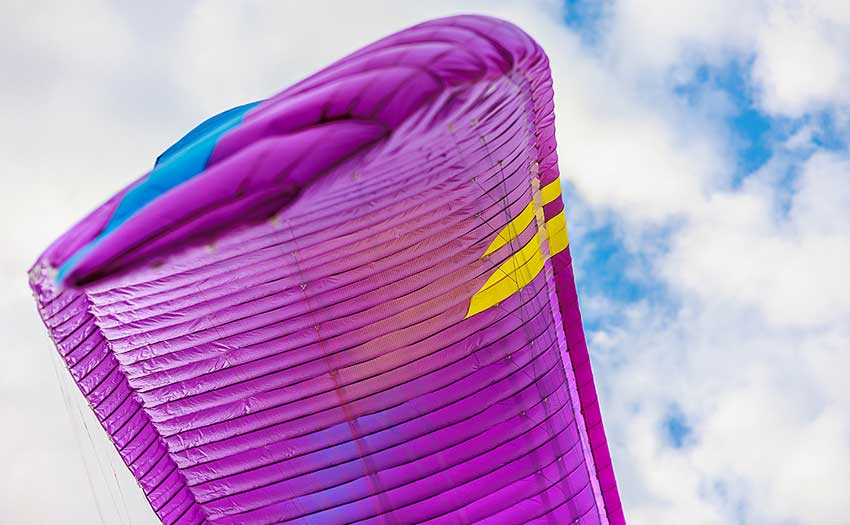
On glide
The glider feels like it is on rails on glide. The winglets do seem to make it easier to control any roll or yaw, even using a relatively light harness as I was. It feels efficient on glide and there is very little of the small movements you get on some wings.
Bar pressure is light and easy to use. Once on bar the pressure on the rear handles is reduced. They are effective at controlling the wing and give good feedback on what the air is doing. The leading edge feels nicely pressurised throughout the range, even when pushing up on the Bs for those extra couple of km/h on final glide. I measured 18km/h above trim at full bar. If any loss of pressure is felt, the wing reacts instantly to pressure on the Bs – you can feel the direct connection to the aerofoil.
Security
In 11 hours I only had one minor tip flutter, which was out before I had the chance to look. The tips feel strong and when the collapse came it didn’t propagate.
Big ears are possible with the outer-As but require quite a bit of pressure to pull in. Once in they seem stable and can be combined with bar. Once released they may need a bit of pumping to flick out. It is also possible to use the B3 technique by pulling the outer Bs. This is effective and seems slightly less prone to snagging on release.
Sprial dives over goal are frowned upon these days (seems they trigger the alarms on the tracking system) but in free flight I found spirals easy to control. It seems those winglets do make it easy to smoothly come out. Although maybe not the most dynamic-feeling wing, it is easy to fly nice big smooth wingovers on the Photon, with the wing retaining energy smoothly.
Conclusion
The Photon is undoubtedly a top racing machine for the sports class and designed for long days flying XC. (Dominik Wicki flew a 300km flat triangle in Switzerland on his new Photon on 22 May, proving the point). Its reassuring feel will help keep you comfortable and stop you becoming tired.
Performance figures are always hard but it definitely holds its own against the other wings I was flying alongside in the SRS. It may not quite be the fastest but its whole range is fully usable with no nasty surprises lurking to catch you out.
The handling takes a few hours to get the best out of it, but if you give yourself time to get acquainted with the wing it will reward you with great climbing ability and speed, making for big XC flights and fast tasks.
Manufacturer’s SPECIFICATIONS
Ozone say: “The Photon brings near-competition class performance to experienced sport class pilots. All of Ozone’s two-liner know-how has gone into designing this wing.”
Use: XC and sports class competition
Pilot level: Sports class pilots and above
Sizes: XS, S, MS, ML, L, XL
Flat area (m²): 19.1, 20.7, 22.3, 23.9, 25.5, 27.3
Take-off (kg): 60-75, 70-85, 80-95, 90-105, 110-115, 110-130
Weight (kg): 4.28, 4.47, 4.75, 5, 5.27, 5.55
Cells: 71
Flat aspect ratio: 6.5
Certification: EN C
Marcus flew the Photon ML (90-105kg) in the southern French Alps and North Macedonia at around 102-103kg, paired with a Woody Valley GTO Light 2 with inflatable protection.
Published in issue 241 (July 2023)


